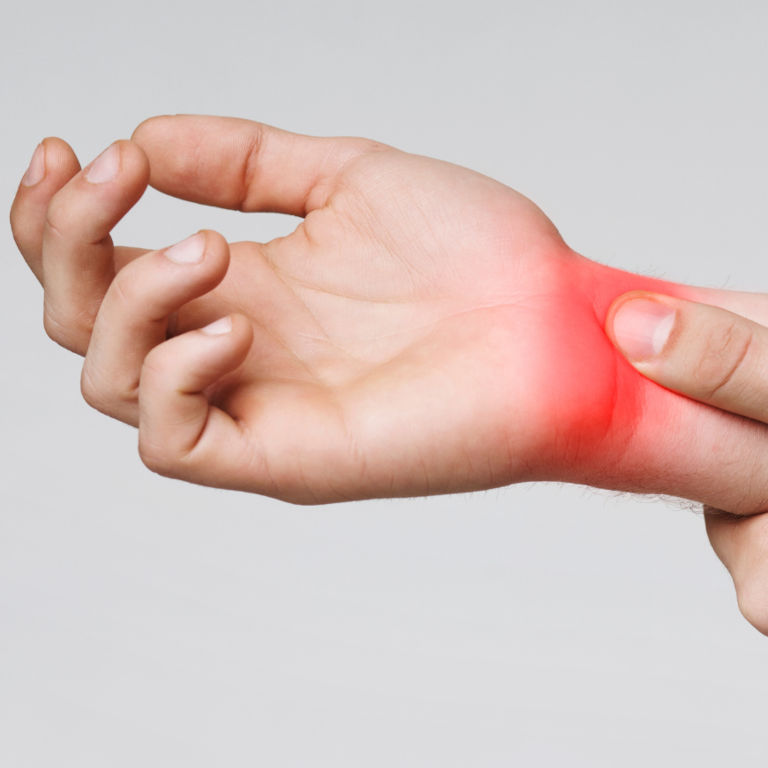
Carpal tunnel syndrome
The carpal tunnel is a space on the anterior aspect of the wrist where the median nerve and nine tendons connect the forearm to the hand. When there is an increase in pressure inside the carpal tunnel that causes compression of the median nerve, we are facing a carpal tunnel syndrome.
The symptoms that this Syndrome causes, when the compression of the mediated nerve is high and therefore its function is affected, are pain, numbness, paresthesia (tingling) and/or weakness of the hand/wrist. The thumb, index, middle and part of the ring finger are the most affected by numbness and tingling. They are usually symptoms that appear at night, however, they can appear during daily activities. There may also be a decrease in prehension, so that objects fall out of the hand. In more severe situations, there is no sensation and the muscles at the base of the thumb are atrophied.
The causes can be diverse, however, they are usually unknown in patients. Tenosynovitis, which can increase pressure in the carpal tunnel, is one cause. Bone dislocations, fractures, and arthritis narrow the canal and are uncommon. Diseases such as hypothyroidism, rheumatoid arthritis, diabetes and kidney failure can also be the cause. During pregnancy, fluid retention can also lead to edema in the carpal tunnel, which generally disappears after delivery.
To diagnose Carpal Tunnel Syndrome, the Orthopedist takes a clinical history, focusing on activities performed with the hand, previous injuries and previous symptoms. In addition, an X-ray is performed to analyze possible causes, such as arthritis or a fracture, visible on an X-ray. An electromyogram may also be requested to confirm the diagnosis and exclude the extension of the syndrome to the forearm, shoulder or cervical spine.
With regard to treatment, for moderate symptoms, physiotherapy is advised, reducing hand activity, keeping the wrist in a neutral position, use of a splint overnight, oral or injected anti-inflammatory drugs. In intense situations without improvement, the resolution of this problem may involve surgery to widen the carpal tunnel in order to reduce the pressure on the nerve. Numbness and paresthesia are symptoms that can disappear quickly, but mobility of the wrist and hand is not immediate, which is why treatment through Physiotherapy is so relevant.
Physiotherapy represents an important step in the treatment of Carpal Tunnel Syndrome to relieve pain, reduce inflammation and improve hand and wrist function. During physiotherapy sessions, different approaches can be used to treat this syndrome.
Education and guidance: The Physiotherapist provide information on proper postures in order to avoid compression of the median nerve and also ergonomic techniques in daily life and at work. It also helps adapt routine activities to reduce wrist and hand overload.
Therapeutic Exercises: Exercises such as stretching, muscle strengthening, and motor coordination are prescribed to strengthen weakened muscles, lengthen shortened muscles, and to improve coordination and control of movements.
Manual Therapy: The Physiotherapist performs Manual Therapy techniques such as massage, joint mobilizations, among others.
Other treatments: Heat or cold therapy, ultrasound and electrotherapy can also be used for treatment.
In conclusion, Carpal Tunnel Syndrome is a painful and debilitating condition that occurs due to compression of the median nerve in the carpal tunnel, resulting in symptoms such as pain, numbness and weakness in the hand and wrist, but with proper treatment, including Physical Therapy and, if necessary, surgery, it is possible to relieve symptoms and improve the function and mobility of the hand and wrist.

